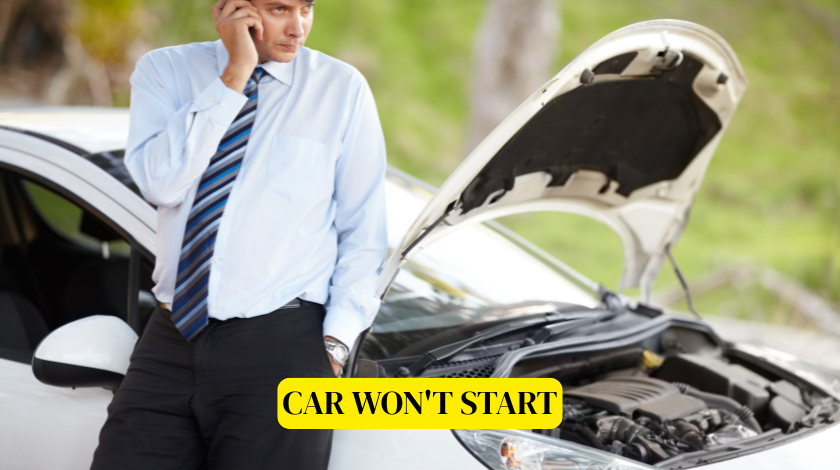Imagine this: you get into your car, turn the key—or hit the start button—and… nothing. Or maybe all the dashboard lights come on, but the engine refuses to roar to life. You try again. Still nothing. That’s a moment of frustration most drivers have faced.
When your car won’t start, it throws your schedule off, leaves you anxious, and can cost money if you guess wrong on what’s broken. But the good news is this: many causes are diagnosable without fancy tools, and many fixes are simple. In this article, I’ll walk you through how to think about a car that won’t start, how to test what’s wrong, how to fix common issues, and what you should leave to a mechanic. I’ll also share some stories from real life, and tips to avoid getting stuck in the future.
By the time you finish reading, you’ll know:
-
What different “won’t start” symptoms mean
-
Which systems to check (battery, starter, fuel, ignition, etc.)
-
How to troubleshoot step by step
-
Typical repair options and cost ranges
-
Tips to prevent these problems
I’ll use plain language, real examples, and try to make it feel like we’re working together in your garage. Let’s dive in.
2. Recognizing symptoms / scenarios of “car won’t start”
Not all “won’t start” situations are the same. The first, and one of the most useful, steps is to observe exactly what happens (or doesn’t) when you try to start the car. These clues help you narrow down which system is likely at fault.
Here are the common scenarios:
2.1 No crank (dead silence)
You turn the key or press start—absolutely nothing happens. No sound of the starter motor, no clicking, no engine turnover. Maybe lights go dim or don’t work.
This symptom often points toward a completely dead electrical path: a dead battery, broken connection, bad fuse, or a failed ignition or starter relay.
2.2 Cranks but won’t fire (engine spins but doesn’t start)
Here, you turn the key (or press start), the engine turns over, you hear the motor spinning, but it never catches. It never “fires up.” You get no combustion, no steady running.
That suggests that electrical power is okay (battery, starter working), but fuel or ignition (spark) is failing.
2.3 Clicking noise when turning the key
When you try to start, you hear a “click-click-click” or a single click, but the engine won’t spin. This often means the starter solenoid is engaging (or trying to), but there’s insufficient current to drive the starter motor, or the starter itself is failing.
2.4 Lights or electronics work but engine doesn’t start
Your headlights, radio, dashboard lights come on, but the engine doesn’t. That tells you there is some electrical power, so the battery isn’t completely dead. But something between power and the starter motor or ignition firmware is failing.
2.5 Intermittent starts
Sometimes it starts, sometimes not. You hit the key a few times, give it a rest, and it suddenly works. That kind of symptom suggests a loose connection, failing component, or something that’s on the edge of failing.
2.6 Doesn’t start in cold weather or extreme conditions
If when it’s cold, or after sitting for a long time, the car won’t start—but works fine otherwise—you’re likely seeing temperature- or condition-related failures. Cold reduces battery capacity; fuel may gel (in diesel); moisture or condensation may cause faults.
These symptom types help you prioritize what to test first.
Read Also: Skyrim gts i don’t have the treat wound ability
3. Possible causes (with details)
Once you have your symptom, the next step is to consider likely causes. Let me walk you through the systems and components that commonly fail, and how they lead to a no-start condition.
3.1 Electrical / battery & charging system
Dead battery or weak battery
This is the first suspect in nearly every no-start case. Batteries die or lose capacity over time, particularly in heat or cold. If the battery doesn’t have enough voltage or current to crank the engine, nothing else will work.
Battery cables, terminals, corrosion, or loose connection
Even if the battery is fine, if its cables or terminals are corroded, loose, or broken, the current can’t flow. A bad ground or poor contact can block power to starter or ignition.
Alternator / charging system failure
If the alternator (that recharges your battery when the engine runs) is failing, the battery won’t recharge properly, and you could end up with a drained battery. After a jump start, the car may run for a while and then die again.
Fuses, relays, wiring, grounding
Within the electrical system, fuses may blow, relays fail, or wiring can be damaged (rodents are known to chew wires). A blown fuse or bad relay in the starter, ignition, or ECU circuit can prevent starting.
3.2 Starting / ignition switch system
Starter motor failure
The starter motor spins the engine to start. If it’s burned out, worn, or jammed, it can’t spin. Symptoms include no crank (silence) or a weak spin.
Starter solenoid / starter relay
The solenoid bridges the high-current path to the starter. If it fails, you may hear a click but no crank. Sometimes tapping the starter lightly can briefly restore contact (a known trick) when the solenoid is failing.
Ignition switch fault
This is the switch (or button) you use to start. If it fails electrically, it won’t send the “start” signal. You might see dash lights, but nothing happens when you twist the key to “start.”
3.3 Fuel / injection / delivery system
If your engine turns over but doesn’t fire, the problem may lie in getting fuel to the cylinders.
Fuel pump failure
If the pump in the tank fails, no fuel will reach the engine. When you turn the key to “on,” you usually hear a faint hum as the pump primes. If you don’t hear that, suspect fuel pump.
Clogged fuel filter or lines
Dirt or contamination can clog the filter or lines, starving the engine of fuel. Over time, filters accumulate debris and need replacement.
Empty fuel tank / wrong fuel
Sometimes the obvious is missed: you’re out of fuel, or someone placed the wrong type (diesel vs gasoline). If your gauge is faulty, the tank might be empty without your knowledge.
3.4 Ignition / spark / combustion failure
Even if your engine cranks and has fuel, no spark means no ignition.
Bad or fouled spark plugs
Spark plugs wear out, get dirty, or foul with deposits, especially if the engine runs rich. A worn plug cannot produce a strong spark to ignite the mixture.
Ignition coils / coil pack issues
Modern cars use coil packs to generate high voltage for plugs. If a coil fails, that cylinder won’t fire.
Distributor cap / rotor (older cars)
In older ignition systems, the distributor routes spark to each plug. Cracks, moisture, or wear can break continuity.
Timing belt / chain, sensor problems
If the timing belt or chain is broken or slipped, valves and pistons are out of sync, and combustion can’t happen. Or a failed sensor (crankshaft or camshaft position sensor) can prevent the ECU from determining when to fire spark.
3.5 Security / electronics / key issues
Modern cars have anti-theft systems that can block starting.
Immobilizer / anti-theft system
If your car doesn’t recognize the key (transponder), the system may disable the starter or fuel supply. You might see a flashing security light.
Key fob battery / transponder issue
If your key fob’s battery is dead, the car may not detect it. You may not be able to start or unlock the car.
ECU / computer faults
If a wiring fault or internal failure to the car’s main computer occurs, it may not allow starting. This is rare, and typically shows error codes.
3.6 Mechanical / engine issues
These are less common in “won’t start” but can be serious.
Low or no compression
If cylinder compression falls (due to worn piston rings, valves, or head gasket failure), combustion can’t occur. The engine may spin but not fire.
Seized engine / internal damage
If the engine is locked (due to lack of oil, damage, or mechanical failure), it may not crank at all.
Broken timing belt / chain (serious)
If the belt/chain has snapped while parked, the camshaft(s) won’t move in sync with the crankshaft, and the engine won’t start. This is a major repair.
4. Diagnostic approach: step-by-step guide
Now that we know the suspects, let’s walk through how you (or a mechanic) can test systematically. The goal is to eliminate possibilities and home in on the fault.
Step 1: Observe and gather symptom data
-
What exactly happens when you try to start?
-
Do you hear clicks, hums, nothing?
-
Do lights / dash / radio work?
-
Did this problem happen suddenly or gradually?
-
What conditions (cold, after sitting, after refueling) preceded it?
Step 2: Test / rule out battery & connections
-
Use a multimeter to measure battery voltage. A healthy, fully charged battery should read ~12.6V (resting). Under load (cranking) it should stay above ~10V.
-
Try jump starting from another vehicle. If engine cranks and starts, battery or charging system is likely culprit.
-
Inspect battery terminals & cables. Clean corrosion, tighten connections, ensure good ground.
Step 3: Test fuses, relays, wiring, continuity
-
Check relevant fuses (starter, ignition, ECU) to see if any are blown.
-
Swap relays (if you have a spare of same type) to check if relay is bad.
-
Inspect visible wiring near battery, starter, engine bay for damage, frayed insulation, rodent damage, burnt wires.
-
Use a test light or continuity tester to confirm power is reaching starter and ignition circuits when key is turned.
Step 4: Check for fuel pump / fuel delivery
-
Turn key to “ON” (not “start”) and listen near fuel tank for pump hum (prime). If you don’t hear it, suspect fuel pump or relay.
-
If possible, use starter fluid in the intake: spray a little into the throttle body while someone cranks the engine. If it fires and sputters, the problem is fuel delivery.
-
Check fuel pump fuse / relay.
-
Confirm there’s fuel in the tank and that fuel filter / lines are not clogged or blocked.
Step 5: Check for spark / ignition faults
-
Remove a spark plug, reattach wire, and ground the metal body to engine block. Crank the engine and see if you observe a spark.
-
If there’s no spark, test ignition coils (swap, measure resistance), check coil supply voltage, check distributor connections if present.
-
If sensors like crankshaft position sensor are accessible, test or swap (if you have spare) or scan for error codes.
Step 6: Test starter / solenoid
-
If when you turn the key, you hear a click or weak spin, the starter may be marginal.
-
Disconnect starter and bench test if possible.
-
Light tapping of the starter sometimes works if internal brushes are failing.
-
Confirm the solenoid is getting voltage and sending voltage to the starter motor when key is engaged.
Step 7: Use diagnostic tools / scan for fault codes
-
If your car has an OBD port, plug in a scanner. See if there are stored trouble codes relating to sensors, immobilizer, etc.
-
Monitor live sensor data for crankshaft or camshaft signal.
-
Use the scan tool to command the fuel pump or test ignition circuits if your tool allows.
Step 8: When to stop and call a mechanic
If you have eliminated obvious faults but the car still won’t start, or you suspect internal engine damage, it’s time to call a professional. Tampering further may make things worse. A mechanic with specialized tools (compression test, oscilloscope, etc.) can pinpoint the issue.
5. Common fixes & cost considerations
Below are typical fixes for each problem area, with rough cost ranges (which vary by region, car make/model, quality of parts, labor).
5.1 Battery replacement / repair
If battery is dead or weak, replacing with a new battery is often cheap and effective. In many places, a decent car battery costs from $50 to $150 (or local equivalent). Installation is usually straightforward. If the battery is under warranty, shop may replace it for free.
5.2 Terminal cleaning, tightening, repair
Cleaning corrosion with baking soda + water or wire brush, tightening connections, repairing frayed cable ends—these are cheap fixes (costing maybe a few dollars in supplies if you do it yourself). A faulty ground strap cable might cost $20–$50 to replace in many markets.
5.3 Alternator repair / replacement
If the alternator fails, you’ll often need to replace or rebuild it. Depending on vehicle model, cost may range from $200 to $600 (parts + labor). In many vehicles, alternator replacement is a mid-level job in terms of difficulty.
5.4 Starter motor / solenoid replacement
Starter units vary in cost. A new starter might cost $100 to $400 depending on the car. Labor depends on how easy it is to access—on some cars, it’s simple; in others, engine components or exhaust must be removed.
5.5 Fuel pump / filter / injector fixes
-
Fuel filter replacement: relatively cheap, maybe $20–$100 depending on vehicle.
-
Fuel pump: more expensive, $200–$500 or more, sometimes requiring tank removal.
-
Fuel injectors: cleaning, replacement, or repair—variable costs depending on number of injectors and vehicle.
5.6 Ignition parts replacement
-
Spark plugs: $10–$30 each, replacing all 4–6 plugs might cost $50–$200.
-
Coils or coil packs: $50–$200 each or more.
-
Distributor parts (if present): modest costs.
-
Sensor replacement (crankshaft, camshaft): $50–$300 depending on vehicle.
5.7 Key / immobilizer fixes
If the immobilizer is at fault, repairing or reprogramming keys, replacing the transponder chip, or reprogramming the ECU may be needed. This might cost $100–$300 or more depending on manufacturer and the locksmith or dealership.
5.8 Engine repairs (serious / major)
If you have internal engine damage or compression loss or broken timing, expect high costs. These repairs could range into the thousands, depending on how extensive the damage is, parts, labor, etc. For example, timing belt replacement with head service might cost $500–$2,000 in many settings.
5.9 Preventive maintenance / tips
-
Regular battery testing and replacement before failure
-
Periodic inspection of cables, terminals, grounds
-
Clean or replace filters
-
Monitor engine warning lights, sensor alerts
-
Use quality fuel
-
Replace spark plugs per service schedule
-
Keep key fob battery fresh
-
Drive your car often (avoiding long idle periods)
6. Real-life stories & cautionary tales
Let me share a personal story. One evening, I got into my car, turned the key, and… silence. Nothing. The radio and lights still worked, but the engine would not turn over. It was late, and I was already running late for a meeting. I assumed battery was dead, asked a friend to jump me, but even after jump starting, the car died a few blocks later.
When a mechanic looked deeper, he found the ground cable was so corroded internally that although current could run low loads (lights, radio), it couldn’t deliver enough to crank the starter. We replaced the cable, and the car was fine after that. The experience taught me never to ignore battery terminal health.
Here’s another: A coworker’s car would start fine in the morning but fail later in the day. Diagnostics showed the fuel pump was failing when it warmed up. During hot spells, the car wouldn’t start. Replacing the pump solved it.
These stories confirm that intermittent or partial symptoms often point to wear, corrosion, heat-sensitivity, or borderline components.
A mistake I’ve seen many make is replacing parts randomly—“I’ll change the starter, hope it fixes it.” That can waste money if the real issue is in wiring, sensors, or alternator. That’s why methodical diagnosis is critical.
7. Tips to avoid “won’t start” problems in the future
Here are some preventive practices — small care now can save big headaches later:
-
Check battery health regularly
Batteries degrade over time. Test voltage, check age. Replace before it completely fails. -
Keep terminals clean and tight
Clean corrosion, tighten clamps, ensure ground strap is good. -
Watch for early warning signs
Dim lights, slow cranking, engine hesitation, strange clicks—all can be early signs. -
Keep up fuel & filters
Replace fuel filter on schedule, use clean fuel, avoid letting tank run too low often. -
Change spark plugs and ignition components per schedule
Worn plugs or coils lead to misfires or hard starts. -
Replace key fob batteries before they die
Don’t let the immobilizer defeat you. -
Drive regularly / avoid long idle periods
Helps keep battery and fuel systems healthy. -
Insulate or protect against weather extremes
In cold climates, a block heater or battery insulation can help starts. -
Listen to weird sounds & respond early
Clicking, hesitation, unusual behavior—don’t ignore them.
8. Conclusion
A car that won’t start is a stressful experience—but in many cases, it’s fixable with logic, basic tools, and patience. The key is to observe the symptom (no crank, crank but no fire, clicking, etc.), then test through the major systems (battery/electrical, starter, fuel, ignition, security). Avoid jumping in and replacing parts blindly. When the problem is elusive or serious (engine internal failure, major wiring fault), it’s time to involve a professional. But many times, you can pinpoint and solve the issue yourself, saving time, hassle, and money.
Start with the easiest checks (battery, cables), move methodically, and work your way deeper. Keep your car maintained, pay attention to signs, and you’ll reduce the risk of being stranded.
9. FAQ (frequently asked questions)
Q1. My lights and radio work, but the car won’t start. Does that mean the battery is okay?
A: Not necessarily. Low electrical load (lights, radio) requires much less current than cranking the engine. A battery may have enough power for small loads but not enough to spin the starter. Always test under load or try a jump.
Q2. Can I jump-start any car to fix the no-start issue?
A: Jump-starting helps diagnose battery/charging problems. If the car starts with a jump, the battery or charging system is suspect. But if it doesn’t, the issue lies elsewhere (starter, wiring, fuel, etc.).
Q3. If I hear a click but no engine spin, what’s the likely cause?
A: That’s often a sign of starter solenoid (or relay) engaging but not supplying enough current to spin the starter, or a failing starter motor itself.
Q4. I sprayed starter fluid and the engine fired briefly. What does that tell me?
A: That strongly indicates a fuel delivery issue (fuel pump, filter, lines). The ignition and spark systems are likely okay in that case.
Q5. Can a bad alternator cause a “won’t start” situation?
A: Yes. If the alternator fails, it cannot recharge the battery. Over time, the battery drains until it can’t crank the engine. After a jump, the car may run for a while but then die.
Q6. When should I stop troubleshooting and call a mechanic?
A: If you’ve tested all obvious parts and still can’t find the issue, or if you suspect internal engine damage, faulty wiring deep in the system, or need specialized tools—get a professional. Don’t risk greater damage.




